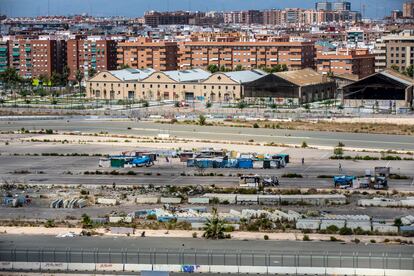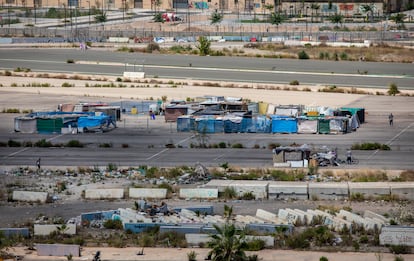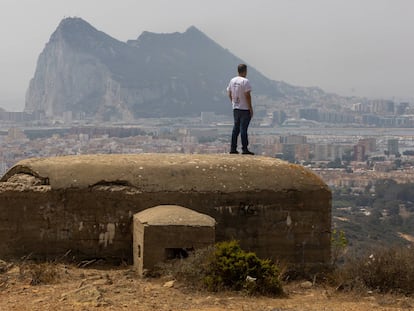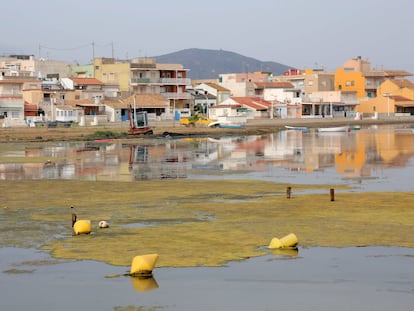The shanty town on Valencia’s abandoned Formula 1 circuit
Around 50 migrants are living on the racing track which cost the regional government €98 million and now lies in disuse

Nabil, 30, didn’t know that the tarmac his shack is on formed part of Valencia’s Formula 1 circuit. Spanish racing driver Fernando Alonso won the Grand Prix the last year the city hosted the event in 2012. Since then, the circuit, which cost the regional authorities €98.5 million to build, has been abandoned. Now, within its perimeter, a small shanty town housing a predominantly migrant community has sprung up while urban planners look for a way out of the real estate legal wrangles impeding development on this prime piece of seafront real estate. At the moment, however, it is home to Nabil, who makes a living helping to park cars on the nearby Malvarrosa beach. He returns in the evening with bags filled with water bottles and food.
Nabil is one of about 50 men living in the space where the European Grand Prix took place between 2008 and 2012 at a total cost of more than €300 million, taking into account the fee, the circuit and the purchase of rights. Most of the migrants here are Saharawis, from the western part of the Sahara desert, but there are also Moroccans, Algerians and sub-Saharans, as well as the odd Spaniard, according to Nabil, who is joined by Boubacar as he describes their circumstances.
Boubacar, 31, is from Mali and lived in one of these precarious and unsanitary shacks until several months ago. Cobbled together from plastic, various kinds of fabric, wooden planks, pieces of old fence, cement blocks and other bits and pieces, the shacks have no electricity or running water. A Spanish flag flies from one; the largest smells of freshly brewed tea. A prostrate man waves as he puts down his drink; another washes his head with water from a basin with the help of a third. The sun is beating down. There is no hint of shade. No one wants to talk; they don’t want to be disturbed.

The people here just want to earn a living. “I take whatever work there is,” says Boubacar, whose Spanish is fluent after eight years in Spain. “I have worked in the fields and also with the elderly. I don’t want anything from anyone. I don’t expect anything either; just to be able to make a living.” Meanwhile, Nabil adds: “I just want to work at whatever there is. During the summer I can earn about €30 a day with the cars. Sometimes people have come to help us.”
According to Isa Lozano, the city councilor for social services, most of the shanty town dwellers have residence and work permits and occasionally get agricultural work such as fruit picking. She adds that the settlement has not created any social conflict in the neighborhood. This view is shared by an occupant of a nearby building, who has watched the shanty town grow, and also the Grau-Port neighborhood association, which is demanding that any development include extensive green zones.
Since the end of 2019, Social Services workers have been monitoring conditions in the makeshift camp. “The settlement has been growing,” says Lozano, who belongs to the left-leaning Compromís party that has been running Valencia City Hall in coalition with the Socialist Party (PSOE) since 2015. “We have 39 who are registered and a dozen who are not yet registered. They have been offered alternatives. We continue to work at it. It is a very striking case as it occupies the middle of the old circuit that is awaiting the Integrated Action Progam for Grau.”
The Integral Action Program (PAI) is a plan to urbanize nearly 300,000 square meters in Valencia’s Grau neighborhood. The macro-operation was proposed when Francisco Camps and Rita Baberá, both of the conservative Popular Party (PP), were the head of the regional and municipal government, respectively, and Spain was in the midst of the property boom.
Since 2012, the F1 circuit, which cost the regional authorities €98.5 million to build, has been abandoned
In May 2007, Formula 1 boss, Bernie Ecclestone, stipulated that both these politicians needed to win their respective elections at the time if they wanted to host the races. At the municipal and regional elections that year, both Camps and Barbará won an absolute majority and Camps declared that the circuit would not cost the people of Valencia “a single euro.” A new neighborhood was simultaneously planned in the Grau district with skyscrapers overlooking the sea that would make use of the circuit as streets. The regional government advanced the payment for the construction of this part of the circuit, a cost that the city of Valencia would pass on to the private developers involved in the project, as announced before the start of the 2008 financial and real estate crisis.
Today, the sum of €42.9 million still owed for the circuit is proving the main stumbling block for the development. The investment group Atitlan, which owns much of the land, and the British fund Hayfin Capital are negotiating with Valencia City Hall over how the project should go forward, according to sources from the department of urban planning. But the obstacles are not just economic.
A corruption probe, known as the Azud case, has been investigating alleged kickbacks the city of Valencia received under the Barbará administration in exchange for favors linked to urban development. In the latest chapter of the case, it emerged last May that the Civil Guard is looking at whether such commissions were paid in the initial sale of the land for the Grau project.
One of those accused in the Azud case is businessman Jaime María Febrer, who was associated with the land’s former owner Acinelav Inversiones 2006, which, with the help of Bancaja – the financial instrument of the regional authorities at the time, later absorbed by Bankia – brought together local investors. Part of this land was subsequently put into the hands of the so-called bad bank, Sareb, before being sold on. The controversial F1 circuit had already been the subject of a legal wrangle but the case was filed in 2019 and the then premier of Valencia, Francisco Camps, was exonerated of responsibility, as the High Court of Valencia considered that there was no embezzlement and the period in which prosecute the alleged crimes could be prosecuted was over.
Notwithstanding, Valencia City Hall hopes to move forward with plans to develop the area that would provide another link between the city and the sea in an area that Nabil and Boubacar are currently calling home.
English version by Heather Galloway.
Tu suscripción se está usando en otro dispositivo
¿Quieres añadir otro usuario a tu suscripción?
Si continúas leyendo en este dispositivo, no se podrá leer en el otro.
FlechaTu suscripción se está usando en otro dispositivo y solo puedes acceder a EL PAÍS desde un dispositivo a la vez.
Si quieres compartir tu cuenta, cambia tu suscripción a la modalidad Premium, así podrás añadir otro usuario. Cada uno accederá con su propia cuenta de email, lo que os permitirá personalizar vuestra experiencia en EL PAÍS.
¿Tienes una suscripción de empresa? Accede aquí para contratar más cuentas.
En el caso de no saber quién está usando tu cuenta, te recomendamos cambiar tu contraseña aquí.
Si decides continuar compartiendo tu cuenta, este mensaje se mostrará en tu dispositivo y en el de la otra persona que está usando tu cuenta de forma indefinida, afectando a tu experiencia de lectura. Puedes consultar aquí los términos y condiciones de la suscripción digital.
More information
Últimas noticias
A survivor’s account of the Interoceanic Train accident: ‘We were scared because of the speed on the curve’
The Interoceanic Train, the Mexican alternative to the Panama Canal
What is known about the Interoceanic Train derailment in Oaxaca
Trump turns a Minnesota fraud allegation into ammunition for his MAGA army against Democrats
Most viewed
- Oona Chaplin: ‘I told James Cameron that I was living in a treehouse and starting a permaculture project with a friend’
- Reinhard Genzel, Nobel laureate in physics: ‘One-minute videos will never give you the truth’
- Why the price of coffee has skyrocketed: from Brazilian plantations to specialty coffee houses
- Pablo Escobar’s hippos: A serious environmental problem, 40 years on
- Chevy Chase, the beloved comedian who was a monster off camera: ‘Not everyone hated him, just the people who’ve worked with him’











































